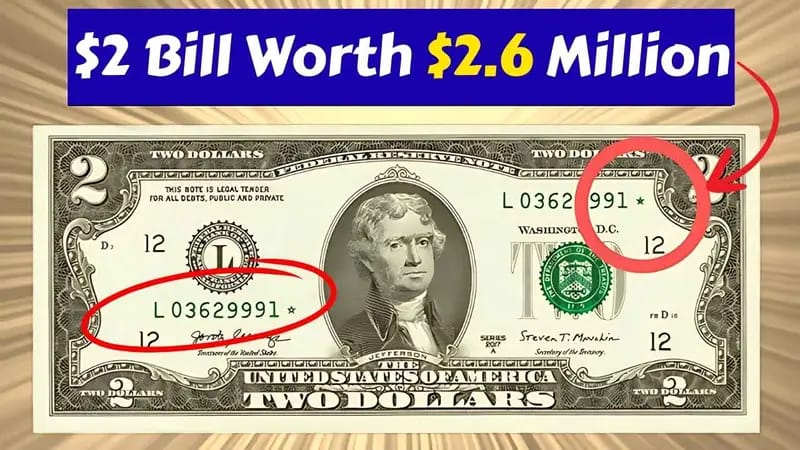We’ve all been there: you stop for gas, hand over a $20 bill, and get a handful of change without a second thought. For most of us, it’s just a mundane part of the day. But for one man, that simple transaction became a life-changing event, proving that incredible treasures can be hiding in the most ordinary places.
The Mechanic’s Million-Dollar Moment
Daniel Harris, a 38-year-old mechanic from Texas, was just finishing up a long day. His stop for fuel was the last errand on his list. When he got his change, he almost didn’t notice the unique-looking $2 bill mixed in with the other cash. But something felt different.
The paper had a distinct, crisp feel—heavier and more substantial than modern currency. His curiosity piqued, he took a closer look. The intricate designs were stunning, and the date stamped on it made his heart skip a beat: 1890. Instead of spending it, he carefully stored it away, sensing it might be special.
Unlocking the Secret of the “Ornate Back”
Daniel’s hunch was right. He dove into research and soon discovered his bill was no ordinary piece of currency. He had stumbled upon an 1890 Treasury Note, specifically from the famed “Ornate Back” series.
These bills are legendary among collectors, celebrated as some of the most artistically beautiful currency the U.S. has ever produced. They were printed for a very short period and feature a large red seal and incredibly detailed, ornate designs on the reverse side—hence the name. The vast majority were lost, destroyed, or worn out over the last 130+ years, making a surviving note in good condition exceptionally rare.
From Wallet to Windfall: The Record-Breaking Sale
To confirm his find, Daniel submitted the bill to the Professional Currency Grading Service (PCGS) for authentication and grading. The experts were astounded. They certified the note in “Gem Uncirculated” condition, a near-perfect grade indicating it had been preserved flawlessly for over a century.
When the note hit the auction block, the collector community went into a frenzy. Bids soared far beyond expectations. When the virtual gavel finally fell, the final price was a staggering $2.6 million, setting a new world record for a $2 bill sale.
Not All $2 Bills Are Created Equal
While Daniel’s story is the jackpot, it’s a reminder that not all valuable currency is ancient. Many $2 bills are worth only face value, but certain editions can be surprisingly valuable. Here’s a quick guide to some potentially valuable $2 bills:
Series Year Key Feature Potential Value Range Why It’s Valuable
1890 “Ornate Back” Treasury Note Up to Millions (if uncirculated) Extreme rarity, age, and iconic design.
1862 First Year of Issue $500 – $3,000+ The original $2 bill. Historical significance.
1918 Large-Size “Lazy Deuce” $200 – $5,000+ Last large-size note. Nicknamed for its horizontal design.
1928 Red Seal $10 – $100+ Early small-size note. Value depends on condition and seal.
1976 Green Seal (Uncirculated) $2 – $20+ Common in circulation, but uncirculated sequential star notes can have premium value.
Modern Misprints & Errors Varies Widely Printing mistakes (misalignments, ink errors) can make any bill valuable.
The Takeaway: Always Check Your Change!
Daniel Harris’s story is the ultimate “what if.” It’s a powerful reminder to slow down and appreciate the small things—literally. That odd-looking coin or slightly different bill in your change could be a hidden artifact.
So next time you pay with cash, take a brief moment to glance at your money. You never know if you’re about to stuff a small fortune into your wallet without realizing it.
Frequently Asked Questions (FAQs)
- How can I tell if my $2 bill is valuable? Look for key features:the year (pre-1960s are generally more valuable), the color of the seal (red seals are often older and more valuable), the size (large-size notes were printed before 1928), and any unique characteristics like star notes or printing errors.
- Where can I get my old currency authenticated? Reputable third-party grading services like the Professional Currency Grading Service(PCGS) or the Numismatic Guaranty Company (NGC) specialize in authenticating and grading paper money. This certification is essential for selling valuable notes.
3. Are the $2 bills from 1976 worth anything? Most 1976$2 bills (the Bicentennial series) are worth exactly $2 if they have been circulated. However, uncirculated bills, especially those with sequential serial numbers or star notes (which replace damaged bills), can hold a small premium for collectors.
- What should I do if I think I have a rare bill? Handle it as little as possible and always hold it by the edges to preserve its condition.Place it in a protective currency sleeve (available online or at coin shops). Then, do some research online or consult with a trusted local coin and currency dealer.
- Why was the 1890 “Ornate Back” note so valuable? Its value comes from a combination of extreme rarity,incredible age, historical significance, and its status as one of the most aesthetically beautiful banknotes ever designed by the U.S. Treasury. Finding one in “gem” uncirculated condition is a once-in-a-lifetime event for collectors.
